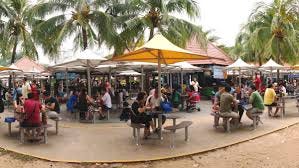In Singapore, one morning after joining Dingo on his very long bike commute to work, Tatum and I enjoyed a morning coffee at Lau Pau Sat, the city’s flagship Hawker Center, along with many smartly-dressed Singaporean office workers. On two consecutive evenings, all four of us (Tatum, Raghav, Janel, Dingo) convened at East Coast Lagoon Food Village, another hawker center, for beers and satay. In the Straits, lights from several hundred anchored ships blinked like a floating city.
The Hawker Centers are the beating heart of Singapore and each is different while operating in a similar fashion. You enter. You set down a tissue packet on an empty table. You go to a stall, or multiple stalls, and get your food and bev. When you’re done eating, you buss the table, making sure to not put plates from non-halal restaurants into the halal rack.



There are private food halls that operate similarly to Hawker Centers and they are called kopitiams. There are also food courts in the major train stations. At one Teo Chew stall in a shopping mall, I saw a young man taking orders, making coffee, and preparing and plating the food, handling a heavy lunch rush by himself. It was hard work in a tiny, steaming space. In ten minutes, there was not one wasted movement. Brutal work.
One afternoon, at a Hawker Center, I saw a non-Indian Asian woman preparing appams by herself in a stall. At first, I thought she may be a worker in an Indian-owned stall. Appams are a niche, regional food, after all. But Dingo piped up with an interesting fact: all Hawker Center stalls must be owner-operated. It’s a stipulation. I walked over and ordered an appam and also read the newspaper article on the wall.
Basically, this Vietnamese woman had applied for and received the license without realizing there was a stipulation attached. The Singapore Govt. ensures that each Hawker Center maintain a certain proportion of restaurants of each ethnic cuisine. She’d accidentally applied for an Indian-food stall. If she wanted to operate, she absolutely had to serve Indian food. So, her neighbor, originally from Kerala and nostalgic of his youth, suggested she learn how to make appams. In a truly Tanpopo-esque story, she went from not knowing what an appam was to serving them to paying customers in about 6 months.
This story, to me, is emblematic of my understanding of Singapore.
Before Singapore became this well-regulated, gleaming global commercial center, it was already a port city where people from all over South and Southeast Asia were coming to make their fortunes. The slick city of today is built on top of that mess and that underlying richness is what gives it a sense of history. And no matter how many Starbuckses and shopping malls pop up, it’ll be hard for generic commercial activity to erase that maritime trade history.
Here’s my rudimentary understanding of it.
The closest thing to native Singaporeans are ‘Peranakans’, a word I’d never heard prior to this trip but now understand to be a multiracial community that trace some lineage to a settler wave from South China that arrived between the 14th and 17th centuries.
Layered onto that group are subsequent arrivals from China, in many waves, and belonging to the following groups: Hainanese, Hunanese, Teochew, Hokkien, and Hakka.
Layered onto that group are the much more recent arrivals from China. The older waves of Chinese-origin Singaporeans refer to themselves as Chinese and the more recent arrivals as Mainland Chinese. The employee at the Teo Chew stall, for example, was most likely Mainland Chinese.
Then, of course, there’s the many, many Malays and Indonesians, who, naturally, seeing that they sandwich Singapore, have a tremendous presence.
Then there’s a historic Indian presence, predominantly Tamilian and especially Tamilian Muslim but also Sikh and Sindhi. There are also many more recent South Asian foreign workers who we routinely saw tending the gardens of the world’s garden city.
On top of this, there’s clearly a presence from the Philippines, Vietnam, Cambodia and, of course, international ‘expats’, as we know they like to call themselves, as opposed to ‘immigrants.’
The ethnic make-up of Singapore at the time of its independence, to some degree, determines its self-conception and this self-conception is preserved in Hawker Centers. Now, add to that, their well-regulated nature and, it becomes clear why Singaporeans and non-Singaporeans alike see these places as emblematic of the city-state.
Their future is slightly endangered though. Running a Hawker Center stall is no joke; it’s hard work. But they must be owner-operated, as I’ve already noted. The next generation aren’t rushing to apply for those licenses. The government may need to revisit its proportioning.
Salvation may come in the form of the more recent arrivals. People like the young man working at the Teo Chew stall in the shopping mall and this Vietnamese woman running an Indian stall. Multicultural melding shaped Singapore’s history. Going forward, it’ll be a different mix.



Hawker centers were my favorite part of visiting Singapore. I'm glad you decided to share these fascinating thoughts and history.
In a few paragraphs Raghav, you've captured a vivid impression of Singapore. From a simple coffee shop in a city center, the entanglement of history, cultures and daily life come alive in your story of the appams stall. Can't wait to visit some day!